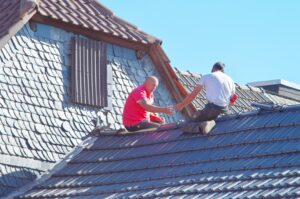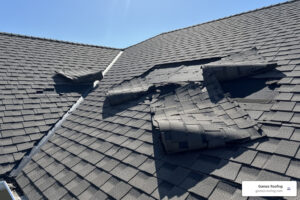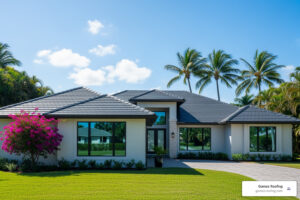Maximize Solar Pool Heating Efficiency
Solar pool heaters harness rooftop-mounted solar collectors to transfer warmth into your pool, ensuring enjoyable water temperatures even when the sun dims behind clouds or winter air cools. By understanding how diffuse radiation, water circulation, and heat loss interact, homeowners can optimize system performance, select hybrid solutions, and maintain year-round comfort. This guide explains how solar radiation feeds thermal collectors, quantifies efficiency drops under overcast skies, examines cooler-weather heat dissipation, and outlines proven strategies—such as proper collector placement, pool covers, and automation—to maximize BTU output. You’ll also discover how hybrid electric-solar systems bridge gaps, why Gomez Roofing’s Florida expertise ensures reliable installations, and how to measure performance to protect your investment in solar pool heating.
How Do Solar Pool Heaters Work to Heat Your Pool?
Solar pool heaters rely on rooftop thermal collectors and a circulation loop to absorb sunlight, transfer heat, and distribute warmed water back into the pool, promoting efficient temperature gain.
What Is a Solar Pool Heater and How Does It Collect Heat?
A solar pool heater consists of UV-resistant collector panels mounted on a roof or decking structure, where pool pump water flows through small channels that absorb solar radiation. These panels employ black polymer or copper tubing bonded to absorber plates, converting sunlight into heat that raises water temperature before returning it to the pool.
How Does Solar Radiation Affect Pool Water Temperature?
Solar radiation intensity directly drives BTU output: more direct insolation yields higher thermal gain, while diffuse or reflected light still produces moderate warming. Pools can gain 50–80 BTU/hr per square foot of collector area on sunny days, with temperature rises of 1–2°F per hour, depending on insolation levels and water volume.
What Role Does Pool Water Circulation Play in Heating Efficiency?
Continuous circulation ensures warmed water from collectors mixes evenly throughout the pool, preventing stratification and maximizing heat distribution. A well-designed loop includes a variable-speed pump, check valves, and a flow meter to maintain optimal 8–12 gallons per minute through each collector, enhancing energy transfer and reducing thermal variance.
How Does Cloudy Weather Impact Solar Pool Heater Efficiency?
Cloud cover reduces available solar energy, cutting BTU output and slowing temperature gains, but systems still capture diffuse light, yielding partial heating.
Does Solar Pool Heating Work in Cloudy Weather?
Solar pool heating systems still function effectively on cloudy days because they rely on light, not direct heat from the sun. Even with cloud cover, sunlight filters through to generate energy, gradually increasing water temperature.
Source: Solaron, Does Solar Pool Heating Work in Cloudy Weather? [2025-05-22]
This source confirms that solar pool heaters can still work on cloudy days, which is relevant to the article’s discussion of efficiency in less-than-ideal conditions.
Why Does Cloud Cover Reduce Solar Radiation and Heat Gain?
Thick clouds scatter and absorb sunlight, dropping direct insolation by up to 80%, which causes solar collectors to receive only diffuse radiation. This reduction in radiation lowers the heat absorbed by collector plates and decreases overall energy input into pool water.
How Much Does Solar Pool Heater BTU Output Drop on Overcast Days?
On overcast days, BTU output typically falls to 10–30% of peak sunny performance. For example, a 200 sq ft collector array producing 12,000 BTU/hr on a clear day may yield only 1,200–3,600 BTU/hr under heavy cloud cover, resulting in temperature gains of 0.1–0.5°F per hour.
Solar Pool Heaters Are Weather Dependent
Solar pool heaters are weather dependent, and their performance is reduced on cloudy days. However, they can still contribute to heating the pool water, even if the efficiency is lower than on sunny days.
Source: Florida Solar Design Group, Solar Pool Heaters Are Weather Dependent, [2021-03-20]
This source supports the article’s discussion of how cloudy weather impacts solar pool heater efficiency.
What Factors Influence Solar Pool Heater Performance During Cloudy Conditions?
Key variables include:
- Cloud thickness and coverage duration
- Ambient air temperature and wind speed
- Collector orientation and tilt angle
- Pool surface area and water volume
Collectively, these factors determine the net thermal benefit under diffuse light and inform strategies like slight tilt adjustments to optimize low-angle radiation capture.
How Effective Is Solar Pool Heating?
Solar pool heaters are effective even on cloudy days, adding heat to the pool water, although the heating process is slower compared to sunny days. The article also mentions that the amount of available sunshine, wind speed, and ambient air temperature all play a role in how efficient a rooftop solar pool heater is on any given day.
Source: Wayne’s Solar, How Effective Is Solar Pool Heating? [2025-05-22]
This source supports the article’s discussion of how cloudy weather impacts solar pool heater efficiency.
What Effects Do Cooler Weather Conditions Have on Solar Pool Heating?
Lower ambient temperatures and nighttime chill accelerate heat loss from pool surfaces and collectors, challenging sustained thermal gains achieved during daylight.
How Does Cooler Ambient Temperature Increase Heat Loss from Pools?
A greater temperature differential between pool water and surrounding air drives convective and evaporative losses, which can exceed solar input. For instance, a 10°F drop in ambient air can increase heat dissipation by 20–30%, requiring additional energy to offset nightly cooling.
What Are Realistic Expectations for Solar Pool Heater Performance in Florida Winters?
In South Florida’s mild winters (daytime highs 65–75°F), solar collectors still deliver 30–50% of peak sunny-day BTUs, translating to 5–10°F temperature increases over several sunny winter days. A properly sized system can maintain pool temperatures in the mid-70s°F with strategic cover use.
How Does Seasonal Variation Affect Solar Pool Heating Efficiency?
| Season | Average Solar Gain | Typical BTU Output |
|---|---|---|
| Summer | High insolation | 12,000–15,000 BTU/hr |
| Spring/Fall | Moderate insolation | 6,000–10,000 BTU/hr |
| Winter | Lower insolation | 3,000–6,000 BTU/hr |
Seasonal shifts in sun angle and day length drive these performance trends, guiding homeowners to adjust collector tilt and cover usage for maximum seasonal efficiency.
What Strategies Maximize Solar Pool Heater Efficiency in Cloudy and Cold Weather?
Combining thermal retention, optimized collector design, and intelligent controls bridges performance gaps on days with limited sunlight or chilly air.
How Do Pool Covers and Insulation Improve Heat Retention?
A quality solar or thermal pool cover prevents 50–70% of nightly heat loss by trapping radiant warmth and reducing evaporation. Insulating the pool’s edge and plumbing lines further curtails conductive losses, ensuring solar gains persist longer after sunset.
Why Is Proper Collector Placement and Sizing Critical for Efficiency?
Collectors oriented within 15° of true south and tilted at an angle equal to your latitude capture maximum solar energy year-round. Oversizing the collector array by 50–100% of pool surface area provides redundancy during cloudy periods, sustaining adequate BTU output when radiation is low.
How Can Smart Control Systems and Automation Enhance Heating Performance?
Automated controllers monitor pool and collector temperatures, engaging solar loops only when collector panels are warmer than the pool, avoiding heat loss during cooler mornings or evenings. Integration with weather forecasts allows preemptive adjustments, optimizing circulation schedules for variable sunlight conditions.
What Are Hybrid Pool Heating Systems and How Do They Improve Year-Round Efficiency?
Hybrid systems combine solar collectors with electric heat pumps or gas heaters to deliver consistent warmth, compensating when solar output dips below pool heating requirements.
How Does a Hybrid System Combine Solar Pool Heaters with Electric Heat Pumps?
During sunny hours, solar collectors provide primary heating while the heat pump remains idle, reducing electricity consumption. When solar output declines—at night, on cloudy days, or during cold snaps—the controller activates the heat pump, maintaining target temperatures with supplemental energy.
What Are the Benefits of Hybrid Pool Heating in Cloudy and Cooler Conditions?
- Consistent temperature control regardless of weather
- Up to 60% lower operating costs compared to standalone heat pumps
- Extended swimming season with minimal manual intervention
Adding a Heat Pump Pool Heater: The Hybrid Advantage
Hybrid systems, which combine solar pool heaters with heat pumps, offer consistent temperatures regardless of cloud cover or cool spells. These systems are particularly beneficial in regions with variable weather, such as the Northeast and Midwest.
Source: Magen eco-Energy US, Solar Pool Heating With Heat Pumps, [2025-05-29]
This source supports the article’s discussion of hybrid pool heating systems and their benefits in cloudy and cooler conditions.
When Should Homeowners Consider Adding a Heat Pump to Their Solar Pool Heater?
- Solar gains drop below desired temperature thresholds for more than three consecutive days
- Nightly heat loss exceeds daily solar heat gain
- Pool usage demands exceed solar-only capacity
Assessing BTU shortfalls against heat pump capacity and cost-benefit analyses determines the optimal timing for a hybrid upgrade.
Why Choose Gomez Roofing for Solar Pool Heater Installation and Service in Florida?
Gomez Roofing combines roofing and solar expertise to deliver turnkey solar pool heating installations tailored to Florida’s climate, backed by craftsmanship and service excellence.
How Does Gomez Roofing’s Local Florida Expertise Enhance Solar Pool Heating Solutions?
Operating across Broward, Palm Beach, and Miami-Dade counties, Gomez Roofing understands regional weather patterns—from humid cloudbanks to winter cold fronts—and configures systems to capture maximum solar radiation while minimizing heat losses unique to South Florida.
Experience the Efficiency of Solar Pool Heaters with Gomez Roofing Co.
Gomez Roofing Co. specializes in designing and installing customized solar pool heating systems for residential and commercial properties in South Florida, taking into account factors such as sun exposure, shading, and roof space to optimize the performance and efficiency of solar pool heaters.
Source: Gomez Roofing, Solar Pool Heaters – Gomez Roofing: Florida Roofing & Solar Solutions, [2025-05-22]
This source provides information on how Gomez Roofing tailors solar pool heating systems to the specific needs of Florida’s climate, which is relevant to the article’s discussion of maximizing efficiency.
What Quality and Customer Service Standards Does Gomez Roofing Provide?
Our technicians adhere to industry-leading installation protocols, including:
- Precision collector alignment and secure roof mounting
- Leak-tested plumbing with UV-resistant materials
- Comprehensive system commissioning and performance verification
We pair this workmanship with ongoing support, seasonal inspections, and transparent communication to safeguard your solar investment.
What Do Customers Say About Gomez Roofing’s Solar Pool Heating Performance?
- “Reliable warmth through winter with only solar—our pool stayed at 75°F even on overcast days.”
- “Hybrid setup cut our winter heating bills by 40% compared to my old electric heater.”
- “Professional installation and prompt service made Gomez Roofing our go-to expert.”
These testimonials reflect our commitment to efficiency, reliability, and customer satisfaction.
While focusing on solar, Gomez Roofing also offers comprehensive Commercial Decking solutions for property managers seeking robust support structures and energy-efficient upgrades. For details on integrating decking and solar systems, explore Commercial Decking – Gomez Roofing.
How Can You Measure and Monitor Solar Pool Heater Performance in Adverse Weather?
Tracking key metrics and engaging professional inspections ensures systems deliver expected thermal gains and identify opportunities for optimization.
What Metrics Indicate Solar Pool Heater Efficiency on Cloudy and Cold Days?
- BTU Output: Hourly thermal gain measured at the controller
- Temperature Gain: Pool water rise per day
- Heat Loss: Difference between nighttime low and daytime high
How Can Homeowners Use Data to Optimize Their Solar Pool Heating System?
- Adjust collector tilt seasonally based on performance logs
- Schedule pump run times around peak insolation hours
- Upgrade insulation or covers when heat-loss rates exceed solar gains
Proactive data-driven tweaks enhance efficiency without major hardware changes.
What Role Does Professional Inspection Play in Maintaining Efficiency?
Annual inspections identify:
- Debris or shading on collectors
- Pump and valve wear affecting flow rates
- Leak points and insulation degradation
Expert diagnostics preserve BTU output and prolong system lifespan, ensuring peak performance even under challenging weather.
Enjoy a warmer pool year-round by applying these strategies, integrating hybrid technology when needed, and partnering with a local expert committed to quality and efficiency. Reach out to Gomez Roofing to design, install, and monitor your solar pool heater—transform cloudy days and cool nights into comfortable swimming moments with confidence.




